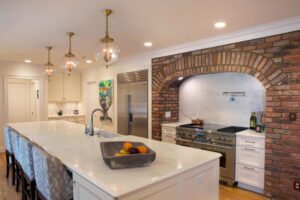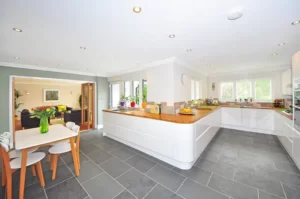The kitchen is not just a place for preparing food and cooking, it also serves as a place for family gatherings, a place to host guests, and a place to make cherished memories. While creating a practical and nice kitchen, lighting is an important factor. The proper lighting may highlight the elements of kitchen and improve the atmosphere while also providing sufficient task lighting. In this article various illuminating kitchen lighting ideas will be discussed to help you creating a well-lit and aesthetically pleasing space.
Creating a Mood with Ambient Lighting
Ambient lighting serves as the over all illumination for kitchen, which also creates a comfortable glow and ambience in the room. A surface-mounted light fixture with dimming ability or recessed ceiling light may be installed. It allows you to modify the brightness according to different events and activities. By installing pendant lights or chandeliers as ambient lighting, you can add a touch of class and personality to your kitchen.
Features are highlighted with accent lighting:
Accent lighting draws attention to certain features or architectural components of your kitchen, giving your kitchen depth and aesthetic interest. To highlight work of art, display shelves, or a decorative backsplash, think about putting adjustable spotlights or track lighting. This highlights a feature and gives your kitchen a sense of improvement. Furthermore, toe kick lighting beneath kitchen island or around the base of cabinets can offer an ambient glow, increasing the general ambience of the room.
Utilizing the Power of Sunlight in Natural Lighting:
For any kitchen, natural light is a great point to start. Besides lighting up the space, it also gives it a sense of openness and freshness. By adding wide windows, skylights or glass doors in your kitchen, you can maximize kitchen light. To make the most of the sunlight during the day, carefully place your kitchen workstations near to those sources. Using natural light not only reduces the need of artificial lighting but it also creates a pleasant and comfortable atmosphere.
Lighting Work Areas with Task Lighting:
For specific work areas in the kitchen that require accurate lighting, task lighting is important. For illuminating countertops and providing sufficient light for cooking, under-cabinet lighting is a preferred option. To prevent shadows and ensure a well-lit workspace, discreetly install LED strip lights or puck lights under the upper cabinets. In addition to being aesthetically pleasing, pendant lights over the kitchen island or peninsula also provides task lighting for tasks like slicing vegetables and reading recipes.
Increasing Convenience and Efficiency with Smart Lighting:
Smart lighting is increasing in popularity in kitchen design as a result of technological improvements. You can utilize voice commands or smartphone apps to adjust the color temperature, brightness, and even the scheduling of your kitchen lights with smart lighting systems. The ease and effectiveness of this degree of management improves your kitchen routine. For a smooth experience, you may pair it with other smart home devices. You can change the illumination according to various tasks, determine lighting presets, or both.
Creating Depth and Balance with Layered Lighting
Layered lighting is essential to create a well-lit kitchen. Layered lighting is the process of combining multiple forms of lighting, such as ambient, task and accent lighting, to create depth and balance in a space. You achieve function and aesthetics by combining fixtures. For a seamless blend of mood, task, and accent lighting, combine recessed ceiling lights with island pendants and under-cabinet lighting.
Going Green with Energy Efficiency
In today’s environmentally conscious society, energy-efficient lighting is an important factor in every kitchen. Choose LED (Light Emitting Diode) bulbs, which use less energy, last longer, and generate less heat than standard incandescent or fluorescent bulbs. LED lighting not only saves energy, but also energy bills. Consider installing motion sensors or timers to automatically turn lights off when not in use to save even more energy.
Conclusion
Finally, lighting is critical to creating an efficient, comfortable and visually appealing kitchen. Natural light, ambient light, task and accent lighting, creating personality with unique fixtures, integrating smart lighting technology and implementing energy efficient solutions are all important considerations. By implementing these great kitchen lighting ideas, you can transform your kitchen into a bright, cheerful environment that meets your practical needs while also reflecting your unique style.



